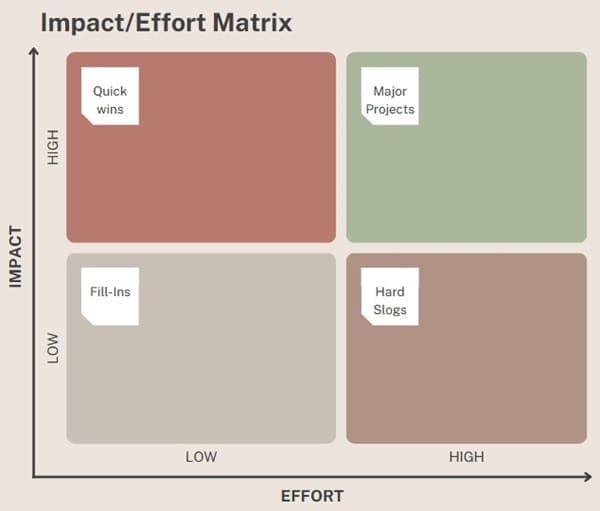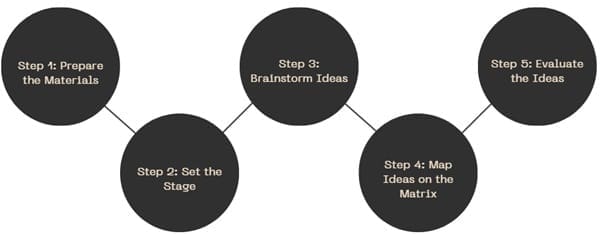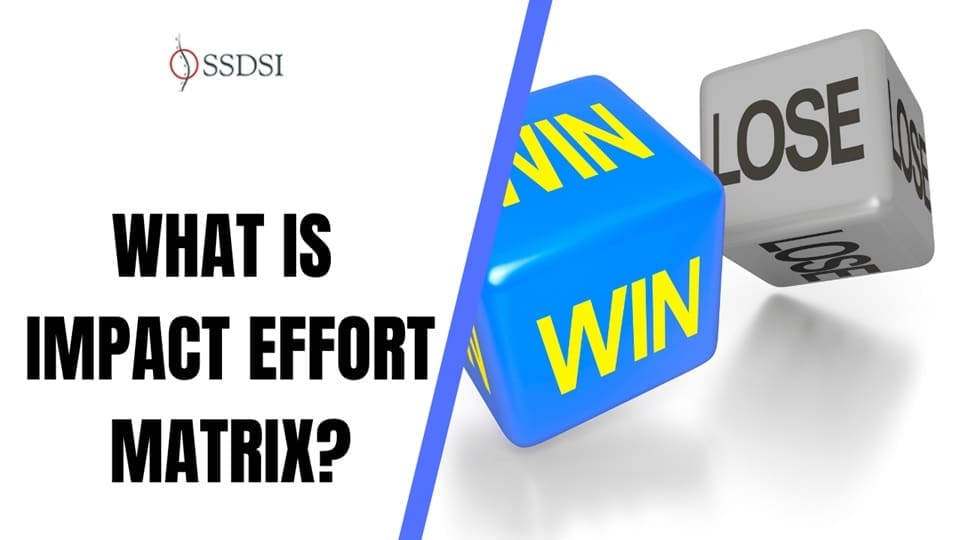In any improvement project, there are many different ideas that could help achieve the desired results. However, not all ideas will be equally effective or feasible. This is where prioritization comes in.
The Impact-Effort Matrix is a structured visual tool that helps teams focus on the most valuable changes by evaluating the impact and effort required for each idea. This tool efficiently directs the team’s energy and resources by helping them decide which ideas to test first.
The Impact-Effort Matrix is helpful in directing attention to high-priority ideas. It encourages collaboration and allows teams to communicate the reasoning behind their choices to stakeholders. In this guide, we will dive deep into what the Impact-Effort Matrix is, how it works, and how to use it effectively.
Table of contents
What is the Impact-Effort Matrix?
The Impact-Effort Matrix evaluates ideas, tasks, or solutions by assessing their potential impact and required effort, helping you determine which are worth pursuing. It helps determine which ideas are worth pursuing based on their potential benefit and the amount of work they require.
In this matrix:
- Impact refers to the potential positive change that the idea will bring.
- Effort refers to the amount of time, resources, and energy required to implement the idea.
By comparing these two factors, the matrix helps identify which ideas will provide the most benefit with the least effort.
The matrix visually categorizes each idea into one of four quadrants:
- High Impact, Low Effort (Quick Wins)
- High Impact, High Effort (Major Projects)
- Low Impact, Low Effort (Fill-Ins)
- Low Impact, High Effort (Hard Slogs)
This classification helps teams quickly identify which actions will provide the most value for the least effort and which ones require more resources but promise higher rewards. By using this matrix, teams can focus on tasks that will move them closer to their goal with minimal resource expenditure.
Why Use the Impact-Effort Matrix?

The Impact-Effort Matrix helps teams make smart decisions about where to allocate their time and resources. It provides the following benefits:
- Clarity: The matrix simplifies decision-making by comparing impact and effort.
- Focus: It helps teams prioritize high-value, low-effort ideas that offer immediate benefits.
- Resource Allocation: It ensures that resources are directed toward the most beneficial projects.
- Team Alignment: The matrix encourages team discussions, helping to align everyone around common priorities.
- Stakeholder Communication: It provides a clear way to explain and justify decisions to stakeholders.
Creating an Impact-Effort Matrix

There are several steps in creating the Impact-Effort Matrix involves several steps. Here’s how to go about it:
Draw a 2×2 Matrix
The first step is to create a 2×2 matrix on a whiteboard or flipchart. You can also use digital tools for this. The matrix consists of four quadrants:
- Vertical Axis: Impact
- Horizontal Axis: Effort
Label the Axes
- The Vertical Axis represents the Impact of each idea. This can range from Low Impact at the bottom to High Impact at the top.
- The Horizontal Axis represents the Effort required to implement the idea. This ranges from Low Effort on the left to High Effort on the right.
List Your Ideas
After brainstorming potential improvement ideas, write each idea on a separate post-it note. This helps keep track of each idea individually and allows for easy movement during discussions.
Evaluate Each Idea
For each idea, the team should evaluate its potential impact and the effort required for implementation:
- Impact Evaluation: Consider how much the idea will contribute to the overall project goals. Is there evidence or data supporting the change’s effectiveness? How significant will the change be?
- Effort Evaluation: Consider the time, resources, and costs involved in implementing the idea. How quickly can it be implemented? Will it require a lot of resources? Is it acceptable to users?
Place the Ideas on the Matrix
Place each post-it note in the appropriate quadrant of the matrix. The four quadrants are:
- High Impact, Low Effort (Quick Wins): These are the ideas that provide significant benefits with minimal effort. They are usually prioritized first.
- High Impact, High Effort (Major Projects): These ideas will have a significant impact but will require substantial time and resources. They come next in priority.
- Low Impact, Low Effort (Fill-ins): These ideas are simple to implement but provide minimal benefits. They can be done when there’s extra time or resources available.
- Low Impact, High Effort (Hard Slogs): These ideas require a lot of effort but offer little benefit. They are usually deprioritized.
Using the Matrix to Make Decisions

The Impact-Effort Matrix allows teams to make decisions by visualizing the relationship between impact and effort. Here’s how to use it effectively:
Quick Wins (High Impact, Low Effort)
These are the ideas that should be prioritized first. Quick wins provide immediate benefits with minimal investment of time or resources. These tasks are often the most rewarding in the short term and can boost team morale. It’s essential to focus on these tasks early on to maintain momentum.
Major Projects (High Impact, High Effort)
These ideas are essential to the success of the project but require a substantial amount of work. They might involve large-scale changes or improvements that need careful planning and resource allocation. We should pursue these after quick wins, though they might need more resources and strategic planning.
Fill-ins (Low Impact, Low Effort)
While these tasks are simple to implement, they provide minimal benefit to the overall project. These can be useful for utilizing extra time or resources when other tasks are not available. They are not a priority but can be helpful in filling gaps.
Hard Slogs (Low Impact, High Effort)
These ideas offer minimal benefit but require considerable effort. It’s often best to deprioritize these ideas or reconsider their feasibility. These tasks are energy-draining and should only be tackled if there’s no other option available.
Role of Team Collaboration in the Matrix
When creating the Impact-Effort Matrix, it’s important to involve the entire project team. Collaboration is crucial because different team members may have different perspectives on the impact and effort of each idea. The matrix encourages conversation and debate, allowing the team to come to a consensus on the best course of action.
Through collaboration, teams can:
- Discuss and align their understanding of what each idea entails.
- Identify potential challenges or benefits that may not be immediately obvious.
- Ensure that everyone agrees on the prioritization of tasks.
Collaboration also helps in building buy-in for the ideas chosen to move forward. Involving everyone in decision-making makes it easier to communicate the reasoning behind the choices to stakeholders.
How to Create the Impact-Effort Matrix?

Creating the Impact-Effort Matrix involves a structured process. Here’s a step-by-step guide on how to develop and use the matrix effectively:
Step 1: Prepare the Materials
Before beginning the activity, gather the materials you will need:
- Introductory slides or talking points for the facilitator.
- A printed template of the Impact-Effort Matrix or a projected slide showing the matrix.
- Sticky notes for participants to write down ideas or solutions.
- A pen or marker for participants to write on the sticky notes.
- A copy of the Impact-Effort Matrix for each participant to guide the discussion.
Step 2: Set the Stage
Start by explaining the purpose of the Impact-Effort Matrix to your team. Clarify that the goal is to prioritize ideas based on their impact and effort. Ensure everyone understands the concepts of impact and effort:
- Impact is the change or result expected from implementing the idea.
- Effort refers to the time, cost, and resources required to implement the idea.
Step 3: Brainstorm Ideas
Ask each participant to brainstorm and write down their ideas on sticky notes. Each idea should be written on a separate note. These ideas could be strategies, projects, or activities that could help achieve the overall goal of the group.
Step 4: Map Ideas on the Matrix
Once everyone has their ideas, the next step is to map them onto the matrix:
- Place the matrix on a whiteboard or large poster, or use a digital version on a screen.
- Label the axes:
- Vertical axis (Impact): Label this axis as “Impact,” with a low-impact area at the bottom and a high-impact area at the top.
- Horizontal axis (Effort): Label this axis as “Effort,” with low effort on the left and high effort on the right.
- Ask the participants to assess each idea based on its effort and impact, placing it in the appropriate quadrant of the matrix. Ideas that require minimal effort but have high impact should go into the top-left quadrant (Quick Wins), and ideas with high impact but high effort should go into the top-right quadrant (Major Projects).
Step 5: Evaluate the Ideas
After placing all the ideas on the matrix, review the placement of each one. Discuss:
- Quick Wins: These easily and quickly implemented solutions deliver high impact. We typically prioritize these ideas first because they offer the most immediate value.
- Major Projects: These solutions require significant effort but offer a high impact. They are important but should be carefully planned and resourced before implementation.
- Fill-Ins: These are low-effort, low-impact solutions. They can be tackled if there is extra time or capacity, but they don’t provide significant value.
- Hard Slogs: These ideas require substantial effort but have little impact. It’s often best to deprioritize these ideas or reconsider their feasibility.
How to Use the Results of the Matrix?
Once all the ideas have been mapped onto the matrix, it’s time to review and finalize the priorities. The group should focus on the ideas that provide the most value for the least effort. The Quick Wins quadrant is typically the starting point, followed by the Major Projects.
Step 1: Review the Final Placements
The facilitator should guide the group in reviewing the placement of each idea. Consider the following:
- Confidence: How confident are we in the impact and effort estimations?
- Data: Can existing data help estimate the impact of each idea more accurately?
- Feasibility: Are there any potential obstacles or barriers to implementation?
Step 2: Make Final Decisions
After discussing the placement of each idea, make final decisions about which ideas to prioritize. These decisions should align with the group’s common goal and strategic priorities.
Step 3: Define Next Steps
After selecting priority actions, decide on the next steps. You can often implement ideas in the Quick Wins quadrant immediately. For Major Projects, create a detailed execution plan.
The results from this activity can inform future strategic planning and implementation efforts.
When to Use the Impact-Effort Matrix?
The Impact-Effort Matrix is suitable for any situation where decisions need to be made about prioritizing actions. It can be used to:
- Prioritize projects or strategies in an organization.
- Select solutions for tackling a specific problem.
- Align team members around common goals and actions.
Benefits of Using an Impact-Effort Matrix
Using an Impact-Effort Matrix offers several advantages:
- Clarity: It simplifies decision-making by clearly showing which ideas provide the most value relative to the effort required.
- Focus: It helps teams focus on high-impact, low-effort tasks that can provide quick wins.
- Resource Allocation: It allows for better allocation of resources by identifying where efforts will yield the greatest returns.
- Stakeholder Communication: It provides a clear way to explain and justify decisions to stakeholders.
Limitations of the Impact-Effort Matrix
While the Impact-Effort Matrix is a valuable tool, it’s important to recognize its limitations:
Subjectivity: The assessment of impact and effort is often subjective. Different people may evaluate the same idea differently, leading to disagreements.
Over-simplification: The matrix simplifies complex decisions. Some ideas may not fit neatly into one of the quadrants and may need further analysis.
Potential Bias: Team members may have biases that influence their perception of impact or effort.
Final Thoughts
The Impact-Effort Matrix is a simple yet powerful tool for prioritizing tasks and projects. It helps teams focus on the most valuable and feasible ideas while ensuring that resources are used effectively. By visually plotting ideas based on their impact and effort, teams can quickly identify where to focus their attention.
To get the most out of the Impact-Effort Matrix, involve your team in the decision-making process and ensure that all perspectives are considered. Keep in mind that the matrix is a tool for guidance and that regular review and refinement are necessary to ensure that the right tasks are prioritized as the project progresses.
By incorporating the Impact-Effort Matrix into your project planning, you can make smarter, more informed decisions that drive success and create meaningful improvements.

About Six Sigma Development Solutions, Inc.
Six Sigma Development Solutions, Inc. offers onsite, public, and virtual Lean Six Sigma certification training. We are an Accredited Training Organization by the IASSC (International Association of Six Sigma Certification). We offer Lean Six Sigma Green Belt, Black Belt, and Yellow Belt, as well as LEAN certifications.
Book a Call and Let us know how we can help meet your training needs.



















